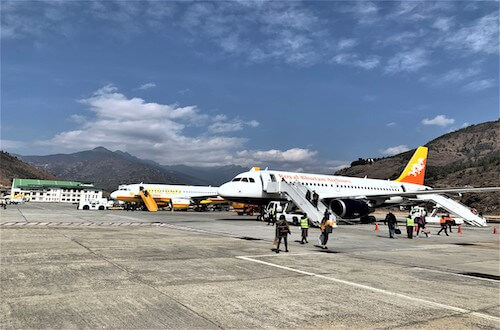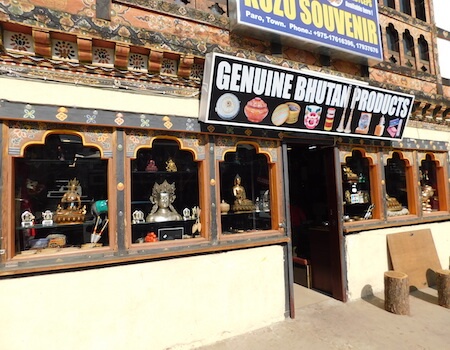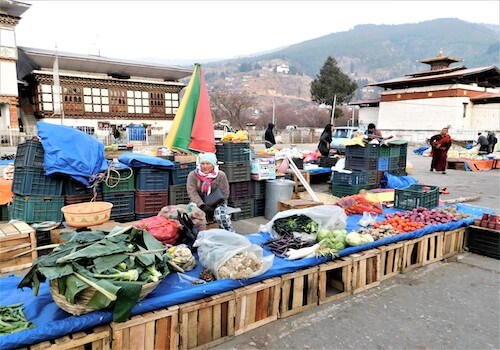 Bhutan’s economy is largely based on agriculture, hydropower, forestry, and tourism which provides livelihood to the majority of the population. 56% of the population depends on agriculture, 22% on industry, and the remaining 22% on services. About 69% of the population dwell in villages, depending upon farms and cattle for livelihood. Because of its rugged mountainous terrain, the development of roads and other infrastructure is difficult, time-consuming, and expensive so the industrial production is primarily of cottage industry type. Bhutan’s economy is also closely aligned with India through strong trade and monetary links and is dependent on India for financial assistance and migrant laborers for major infrastructural development projects such as road construction and hydropower.
Bhutan’s economy is largely based on agriculture, hydropower, forestry, and tourism which provides livelihood to the majority of the population. 56% of the population depends on agriculture, 22% on industry, and the remaining 22% on services. About 69% of the population dwell in villages, depending upon farms and cattle for livelihood. Because of its rugged mountainous terrain, the development of roads and other infrastructure is difficult, time-consuming, and expensive so the industrial production is primarily of cottage industry type. Bhutan’s economy is also closely aligned with India through strong trade and monetary links and is dependent on India for financial assistance and migrant laborers for major infrastructural development projects such as road construction and hydropower.
Hydro Power is the backbone of the Bhutanese economy. By virtue of its geographical location on the southern slope of the Eastern Himalayas, Bhutan is blessed by nature with altitudinal varying landmass with excellent vegetation cover, the perennial flow of water in the swift-flowing rivers, and fair climatic conditions. Its ability to harness the hydropower resources has been made possible due to close and friendly ties with neighbour India which has been the lead donor in providing both technical and financial assistance to develop the numerous hydropower projects in Bhutan. The relationship to develop the hydropower sector has been a win-win situation for both countries as India has huge power demand while Bhutan has tremendous hydropower potential. Most of Bhutan’s hydropower plants are mainly run-of-the-river schemes with no impact or minimal impact on the environment and all the plans and policies in the hydropower sector are geared towards contributing to achieving economic self-reliance and overall socio-economic development of the country.
 Bhutan's 69% of the population living in the rural areas engaged in economic activities that are based on natural resources. Typically, rural livelihood in the country is supported by farming which is characterized by inherent interdependence among forests, livestock, and agricultural enterprises. The country is endowed with diverse ecosystems owing to the natural occurrence of complex physiographic and climatic settings. These diverse ecosystems provide a basis for the social, economic, and cultural developments of the country. Agrarian practices consist largely of subsistence farming and animal husbandry. Agricultural produce includes rice, chilies, dairy (some yak, mostly cow) products, buckwheat, barley, root crops, apples, citrus, and maize.
Bhutan's 69% of the population living in the rural areas engaged in economic activities that are based on natural resources. Typically, rural livelihood in the country is supported by farming which is characterized by inherent interdependence among forests, livestock, and agricultural enterprises. The country is endowed with diverse ecosystems owing to the natural occurrence of complex physiographic and climatic settings. These diverse ecosystems provide a basis for the social, economic, and cultural developments of the country. Agrarian practices consist largely of subsistence farming and animal husbandry. Agricultural produce includes rice, chilies, dairy (some yak, mostly cow) products, buckwheat, barley, root crops, apples, citrus, and maize.
Tourism began in Bhutan, in 1974 and since then it has consistently grown to play a major role in the Bhutanese economy and second highest contributor to the national exchequer. The Royal Government of Bhutan recognizes that tourism is a worldwide phenomenon and an important means of achieving socioeconomic development, particularly for developing countries like Bhutan. It also recognizes that tourism, in allowing traveling, can help in promoting understanding among peoples and building closer ties of friendship based on appreciation and respect for different cultures and lifestyles. Towards achieving this objective, the Royal Government, since the inception of tourism in the year 1974, has adopted a very cautious approach to the growth and development of tourism. The Bhutanese tourism industry is based on the principle of sustainability which is ‘tourism must be environmentally and ecologically friendly, socially and culturally acceptable and economically viable’. Since its inception, the tourism industry in Bhutan has continued to grow with a significant contribution to socio-economic development through revenue foreign currency generation, and employment creation. In 2019, the tourism industry generated a total gross receipt of USD 88.63 million through international and regional tourists.
95% percent of the industry in Bhutan is of small and cottage scale (CSI). 79 percent of CSI is dominated by the service sector while Production and Manufacturing sector accounts for only  10 percent and the remaining about 10 percent is comprised of the contract sector. The CSI sector has been identified as one of the flagship programs because of its greater socio-economic roles. Cottage and Small Industries help drive innovation and investment, diversify the economic base, create employment opportunities, curb rural-urban migration, reduce poverty, and has the potential to contribute towards Bhutan’s economic self-reliance. Small cottage industries manufacturing food products, handicrafts, and handloom are found in several regions.
10 percent and the remaining about 10 percent is comprised of the contract sector. The CSI sector has been identified as one of the flagship programs because of its greater socio-economic roles. Cottage and Small Industries help drive innovation and investment, diversify the economic base, create employment opportunities, curb rural-urban migration, reduce poverty, and has the potential to contribute towards Bhutan’s economic self-reliance. Small cottage industries manufacturing food products, handicrafts, and handloom are found in several regions.
The Manufacturing sector is another major contributor to national revenue. With the industrial sector established in Pasakha, small-scale industries such as cement plants, calcium and carbide, steel and Ferro silicon, Coca-Cola, and also wood-based industries have started developing.
Bhutan’s major imports are petroleum products, mineral products, base metals, machinery & electrical appliances, automobiles & spares, wood, plastic, rubber, spices, and processed food. 80% of all imports are from India while the remaining is sourced from South Korea, Thailand, Singapore, Japan, China, and Nepal. Bhutan’s main export partner is India which accounts for around 90% of the total. Export of electricity to India constitutes around 50% and other exports include metals, minerals, chemical products, timber, raw silk, fruit products, and rubber products. Other export partners include Hong Kong, Bangladesh, Japan, Nepal and Singapore.